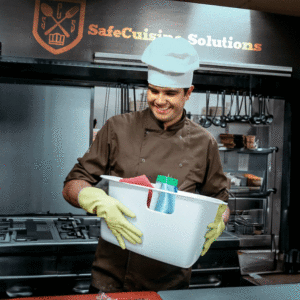
Maintaining a clean and sanitary kitchen is vital for ensuring food safety and preventing the spread of foodborne illnesses. Proper cleaning and sanitizing practices play a crucial role in eliminating harmful bacteria, viruses, and other contaminants that can compromise the safety of the food prepared in your kitchen. In this blog post, we will outline effective cleaning and sanitizing practices to help you create a safe and hygienic kitchen environment.
- Develop a Cleaning Schedule: Establish a comprehensive cleaning schedule that outlines the tasks, frequency, and responsible individuals for each cleaning activity. This includes daily, weekly, and monthly tasks such as surface cleaning, equipment maintenance, and deep cleaning. Adhering to a schedule ensures that cleaning tasks are consistently performed and reduces the risk of overlooked areas.
- Separate Cleaning and Food Preparation Areas: Clearly define separate zones for cleaning and food preparation. This prevents cross-contamination between cleaning chemicals, equipment, and utensils with food contact surfaces. Designate specific areas, tools, and color-coded cleaning supplies for each zone to maintain segregation and minimize the risk of cross-contamination.
- Clean as You Go: Encourage your staff to adopt a “clean as you go” approach throughout their work shift. Promptly clean and sanitize surfaces, utensils, and equipment after use. Discard waste properly and maintain a clutter-free workspace to minimize the accumulation of dirt and potential harborage areas for pests.
- Use Proper Cleaning Agents: Select appropriate cleaning agents suitable for different surfaces and equipment in your kitchen. Refer to manufacturer instructions and ensure compatibility with food contact surfaces. Use designated detergents, degreasers, and sanitizers to effectively remove grease, dirt, and food residues. Avoid using cleaning agents that may leave harmful residues or taint food.
- Follow Correct Cleaning Techniques: Train your staff on proper cleaning techniques to ensure thorough and effective cleaning. This includes using correct scrubbing motions, applying sufficient pressure, and paying attention to hard-to-reach areas. Use brushes, scrubbers, and scouring pads appropriate for the surface being cleaned. Rinse surfaces thoroughly after cleaning to remove any residue.
- Implement a Sanitizing Step: Sanitization is essential to kill remaining bacteria and ensure a hygienic environment. After cleaning, use an approved sanitizer to disinfect surfaces, utensils, and equipment. Follow manufacturer guidelines for dilution ratios, contact time, and proper application methods. Pay special attention to high-touch surfaces, cutting boards, knives, and food preparation areas.
- Maintain Equipment and Utensil Hygiene: Regularly clean and sanitize equipment, utensils, and food contact surfaces. Pay attention to hidden areas, such as crevices, joints, and handles, where contaminants can accumulate. Implement a routine maintenance schedule for equipment, ensuring proper cleaning, lubrication, and calibration as necessary.
- Train and Educate Staff: Provide comprehensive training to your staff on proper cleaning and sanitizing practices. Emphasize the importance of hygiene, personal protective equipment (PPE), and following standard operating procedures (SOPs). Encourage open communication, provide refresher training sessions, and stay updated on the latest industry best practices and regulations.
Effective cleaning and sanitizing practices are essential for maintaining a safe and hygienic kitchen environment. By developing a cleaning schedule, separating cleaning and food preparation areas, adopting a “clean as you go” approach, using proper cleaning agents and techniques, implementing sanitization steps, and providing staff training, you can create a kitchen that prioritizes food safety and minimizes the risk of foodborne illnesses. Implement these practices consistently and encourage a culture of cleanliness and attention to detail. Together, let’s build a kitchen environment that ensures the health and well-being of both staff and customers.
At SafeCuisine Solutions, we offer comprehensive consulting services to help you establish effective cleaning and sanitizing practices in your kitchen. Contact us today to create a customized plan that ensures food safety and maintains a hygienic environment.

